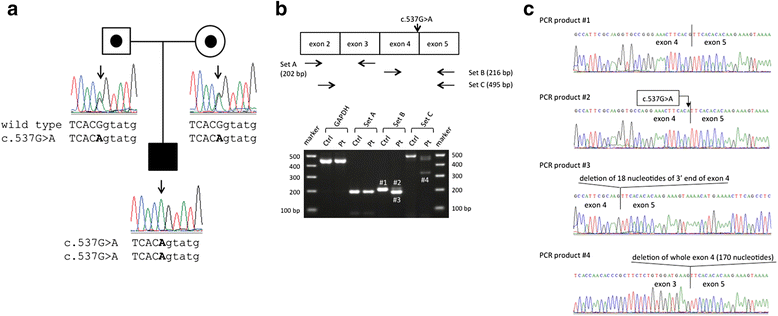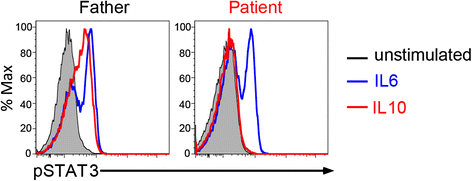Novel exonic mutation inducing aberrant splicing in the IL10RA gene and resulting in infantile-onset inflammatory bowel disease: a case report
- PMID: 26822028
- PMCID: PMC4730728
- DOI: 10.1186/s12876-016-0424-5
Novel exonic mutation inducing aberrant splicing in the IL10RA gene and resulting in infantile-onset inflammatory bowel disease: a case report
Abstract
Background: Although deleterious mutations in interleukin-10 and its receptor molecules cause severe infantile-onset inflammatory bowel disease, there are no reports of mutations affecting this signaling pathway in Japanese patients. Here we report a novel exonic mutation in the IL10RA gene that caused unique splicing aberrations in a Japanese patient with infantile-onset of inflammatory bowel disease in association with immune thrombocytopenic purpura and a transient clinical syndrome mimicking juvenile myelomonocytic leukemia.
Case presentation: A Japanese boy, who was the first child of non-consanguineous healthy parents, developed bloody diarrhea, perianal fistula, and folliculitis in early infancy and was diagnosed with inflammatory bowel disease. He also developed immune thrombocytopenic purpura and transient features mimicking juvenile myelomonocytic leukemia. The patient failed to respond to various treatments, including elemental diet, salazosulfapyridine, metronidazole, corticosteroid, infliximab, and adalimumab. We identified a novel mutation (c.537G > A, p.T179T) in exon 4 of the IL10RA gene causing unique splicing aberrations and resulting in lack of signaling through the interleukin-10 receptor. At 21 months of age, the patient underwent allogeneic hematopoietic stem cell transplantation and achieved clinical remission.
Conclusions: We describe a novel exonic mutation in the IL10RA gene resulting in infantile-onset inflammatory bowel disease. This mutation might also be involved in his early-onset hematologic disorders. Physicians should be familiar with the clinical phenotype of IL-10 signaling defects in order to enable prompt diagnosis at an early age and referral for allogeneic hematopoietic stem cell transplantation.
Figures


Similar articles
-
Phenotypic Characterization of Very Early-Onset Inflammatory Bowel Disease with Interleukin-10 Signaling Deficiency: Based on a Large Cohort Study.Inflamm Bowel Dis. 2019 Mar 14;25(4):756-766. doi: 10.1093/ibd/izy289. Inflamm Bowel Dis. 2019. PMID: 30212871
-
Infantile-onset inflammatory bowel disease in a patient with Hermansky-Pudlak syndrome: a case report.BMC Gastroenterol. 2019 Jan 11;19(1):9. doi: 10.1186/s12876-019-0929-9. BMC Gastroenterol. 2019. PMID: 30634918 Free PMC article.
-
Clinical features of interleukin 10 receptor gene mutations in children with very early-onset inflammatory bowel disease.J Pediatr Gastroenterol Nutr. 2015 Mar;60(3):332-8. doi: 10.1097/MPG.0000000000000621. J Pediatr Gastroenterol Nutr. 2015. PMID: 25373860
-
The clinical, molecular, and therapeutic features of patients with IL10/IL10R deficiency: a systematic review.Clin Exp Immunol. 2022 Jun 23;208(3):281-291. doi: 10.1093/cei/uxac040. Clin Exp Immunol. 2022. PMID: 35481870 Free PMC article.
-
IL-10 and IL-10 receptor defects in humans.Ann N Y Acad Sci. 2011 Dec;1246:102-7. doi: 10.1111/j.1749-6632.2011.06339.x. Ann N Y Acad Sci. 2011. PMID: 22236434 Review.
Cited by
-
Cord Blood Transplantation for Very Early-Onset Inflammatory Bowel Disease Caused by Interleukin-10 Receptor Deficiency.J Clin Immunol. 2024 Feb 19;44(3):67. doi: 10.1007/s10875-024-01669-x. J Clin Immunol. 2024. PMID: 38372823
-
Sevelamer-induced Gastrointestinal Mucosal Injury: A Critical Review for Clinicians.J Community Hosp Intern Med Perspect. 2024 Nov 2;14(6):58-65. doi: 10.55729/2000-9666.1424. eCollection 2024. J Community Hosp Intern Med Perspect. 2024. PMID: 39839182 Free PMC article. Review.
-
The landscape of rare genetic variation associated with inflammatory bowel disease and Parkinson's disease comorbidity.Genome Med. 2024 May 14;16(1):66. doi: 10.1186/s13073-024-01335-2. Genome Med. 2024. PMID: 38741190 Free PMC article.
-
Valuable clinical indicators for identifying infantile-onset inflammatory bowel disease patients with monogenic diseases.World J Gastroenterol. 2021 Jan 7;27(1):92-106. doi: 10.3748/wjg.v27.i1.92. World J Gastroenterol. 2021. PMID: 33505153 Free PMC article.
-
Phenotypic and genotypic characterization of inflammatory bowel disease in children under six years of age in China.World J Gastroenterol. 2018 Mar 7;24(9):1035-1045. doi: 10.3748/wjg.v24.i9.1035. World J Gastroenterol. 2018. PMID: 29531467 Free PMC article.
References
Publication types
MeSH terms
Substances
Grants and funding
LinkOut - more resources
Full Text Sources
Other Literature Sources

